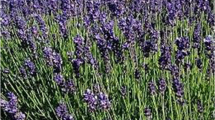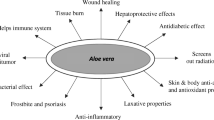Abstract
Mexican Arnica Anti–Inflammatory Action: Plant Age Is Correlated with the Concentration of Anti–inflammatory Sesquiterpenes in the Medicinal Plant Heterotheca inuloides Cass. (Asteraceae). Mexican árnica (Heterotheca inuloides Cass.) is a widely used anti–inflammatory medicinal plant in Mexican folk medicine. Although it has been suggested that plant age, fertilization, and harvesting regime influence the concentration of secondary compounds affecting the therapeutic activity of the plant, the effect of these variables on the concentration of the Mexican árnica anti–inflammatory compounds was not known. We quantified anti–inflammatory sesquiterpenes (caryolan–1, 9β–diol, cadalen–15–oic acid, 7–hydroxycadalene, 4–hydroxy–2–isopropyl–4, 7–dimethyl–1[4H] naftalinone, 7–hydroxy–4αH–3, 4–dihydrocadalene, β–caryophyllene, and β–caryophyllene epoxide) in Mexican árnica plants subjected to fertilization and successive harvests of flowering stems, conditions that mimic the cultivation and harvesting for árnica in México. Fertilization and successive harvesting and their interaction had no significant effect on the concentration of anti–inflammatory compounds. However, the concentrations of these compounds were 60% higher in flowering stems from 15–month–old plants than in those from 4– or 8–month–old plants and was independent of the number of harvests and fertilization regime applied.


Similar content being viewed by others
Literature Cited
Argueta Villamar, A., L. M. Cano Asseleih, and M. E. Rodarte (coordinadores). 1994. Atlas de las Plantas de la Medicina Tradicional Mexicana. Instituto Nacional Indigenista. México, D.F., Mexico.
Arteche, A., B. Vanaclocha, J. I. Güenechea, and R. Martínez. 1998. Fitoterapia. Vademécum de prescripción, 3rd Ed. Editorial Masson S.A., Barcelona.
Bryant, J. P., F. S. Chapin, and D. R. Klein. 1983. Carbon/Nutrient Balance of Boreal Plants in Relation to Vertebrate Herbivory. Oikos 40:357–368.
Delgado, G., M. S. Olivares, M. I. Chávez, T. Ramírez–Apan, R. Bye, E. Linares, and F. J. Espinosa–García. 2001. Anti–Inflammatory Constituents from Heterotheca inuloides. Journal of Natural Products 64:861–864.
Frischknecht, P. M., M. Batting, and T. W. Baumann. 1987. Effect of Drought and Wounding Stress on Indole Alkaloid Formation in Catharanthus roseus. Phytochemistry 26:707.
Gené, R. M., L. Segura, T. Adzet, E. Marin, and J. Iglesias. 1998. Heterotheca inuloides: Anti–Inflammatory and Analgesic Effect. Journal of Ethnopharmacology 60:157–162.
Hamilton, J. G., A. R. Zangerl, E. H. DeLucia, and M. R. Berenbaum. 2001. The Carbon–Nutrient Balance Hypothesis: Its Rise and Fall. Ecology Letters 4:86–95.
Harper, J. L. 1989. The Value of the Leaf. Oecologia 80:53.
Hartley, S. E., K. Nelson, and M. Gorman. 1995. The Effect of Fertilizer and Shading on Plant Chemical Composition and Palatability to Orkney Voles, Microtus arvalis orcadensis. Oikos 72:79–87.
Jerga, C., I. Merfort, and G. Willuhn. 1990. Flavonoid Glycosides and Other Hydrophilic Compounds from Flowers of Heterotheca inuloides. Planta Medica 56:413–415.
Kubo, I., K. Ishiguro, S. K. Chauchuri, Y. Kubo, Y. Sánchez, and T. Ogura. 1995. A Plant Growth Inhibitory Sesquiterpenoid from Heterotheca inuloides. Phytochemistry 38:553–554.
Kubo, I., S. K. Chaudhui, Y. Kubo, Y. Sánchez, T. Ogura, T. Saito, H. Ishikawa, and H. Haraguchi. 1996. Cytotoxic and Antioxidative Sesquiterpenoids from Heterotheca inuloides. Planta Medica 65:427–430.
Linares, E., R. Bye, and B. Flores. 1999. Medicinal Plants of Mexico: Traditional Uses and Remedies. SIGSA, Instituto de Biología, Universidad Nacional Autónoma de México, México, D.F., Mexico.
Martínez, M. 1976. Las Plantas Medicinales de México. Ediciones Botas, México, D.F., Mexico.
Muzika, R. M. 1993. Terpenes and Phenolics in Response to Nitrogen Fertilization: A Test of the Carbon/Nutrient Balance Hypothesis. Chemoecology 4:3–7.
Muzika, R. M., K. S. Pregitzer, and J. W. Hanover. 1989. Changes in Terpene Production Following Nitrogen Fertilization of Grand Fir (Abies grandis (Dougl.) Lindl.) Seedlings. Oecologia 80:485–489.
Nitao, J. K., A. R. Zangerl, and M. R. Berenbaum. 2002. CNB: Requiescat in Pace? Oikos 98:540–546.
Rhoades, D. F. 1979. Evolution of Plant Chemical Defense against Herbivores. Pages 4–55 in G. A. Rosenthal and D. H. Janzen, eds., Herbivores. Their Interactions with Secondary Plant Metabolites. Academic Press, New York.
Segura, L., B. Freixa, T. Ringbom, R. Vila, P. Perera, T. Adzet, L. Bohlin, and S. Cañigueral. 2000. Anti–Inflammatory Activity of Dichlorometane Extract of Heterotheca inuloides in Vivo and in Vitro. Planta Medica 66:553–555.
Segura–Pandanès, L. 1997. Contribución al estudio fitoquímico y de actividad antiinflamatoria de especies vegetales iberoamericanas: Heterotheca inuloides Cass. y Anthurium cerrocampanense Croat. Doctoral Thesis, Departamento de Farmacología y Química Terapéutica, Barcelona: University of Barcelona, p. 272.
Shimizu, M., H. Shogawa, T. Matsuzawa, S. Yonezawa, T. Hayashi, M. Arisawa, S. Suzuki, M. Yoshizaki, N. Morita, and E. Ferro. 1990. Anti–Inflammatory Constituents of Topically Applied Crude Drugs. IV. Constituents and Anti–Inflammatory Effect of Paraguayan Crude Drug “Alhucema” (Lavandula latifolia Medik.). Chemical Pharmaceutical Bulletin 38:2283–2284.
Thorin, J. and H. Nommik. 1974. Monoterpene Composition of Cortical Oleoresin from Different Clones of Pinus sylvestris. Phytochemistry 13:1879–1882.
Trease, G. E. and W. C. Evans. 1991. Tratado de Farmacognosia. 13th Ed. Editorial Interamericana Mc–Graw Hill, México, D.F., Mexico, pp. 71–73.
Van Noordwijk, A. J. and G. de Jong. 1986. Acquisition and Allocation of Resources: Their Influence on Variation in Life History Tactics. American Naturalist 128:137–142.
Waterman, P. G. and S. Mole. 1989. Extrinsic Factors Influencing Production of Secondary Metabolites in Plants. Pages 107–134 in E. A. Bernays, ed., Insect–Plant Interactions. Vol. 1. CRC Press, Boca Raton, Florida.
Zummo, G. R., J. C. Segers, and J. H. Benedict. 1984. Seasonal Phenology of Allelochemicals in Cotton and Resistance to Bollworm (Lepidoptera: Noctuidae). Environmental Entomology 13:1287–1290.
Acknowledgements
We are grateful to Heberto Ferreira Medina, Saúl Bernabé Caballero, and Miguel Trejo for their technical support. This project was partially supported by DGAPA, UNAM (Project IN233202), and The International Cooperative Biodiversity Group’s “Bioactive Agents from Dry Land Plants of Latin America” Grant UO1TW00316 from the National Institutes of Health, National Science Foundation, U.S. Department of Agriculture, and U.S. Agency for International Development.
Author information
Authors and Affiliations
Corresponding author
Rights and permissions
About this article
Cite this article
Maldonado–López, Y., Linares–Mazari, E., Bye, R. et al. Mexican Arnica Anti–Inflammatory Action: Plant Age is Correlated with the Concentration of Anti–Inflammatory Sesquiterpenes in the Medicinal Plant Heterotheca inuloides Cass. (Asteraceae)1 . Econ Bot 62, 161–170 (2008). https://doi.org/10.1007/s12231-008-9015-x
Received:
Accepted:
Published:
Issue Date:
DOI: https://doi.org/10.1007/s12231-008-9015-x




